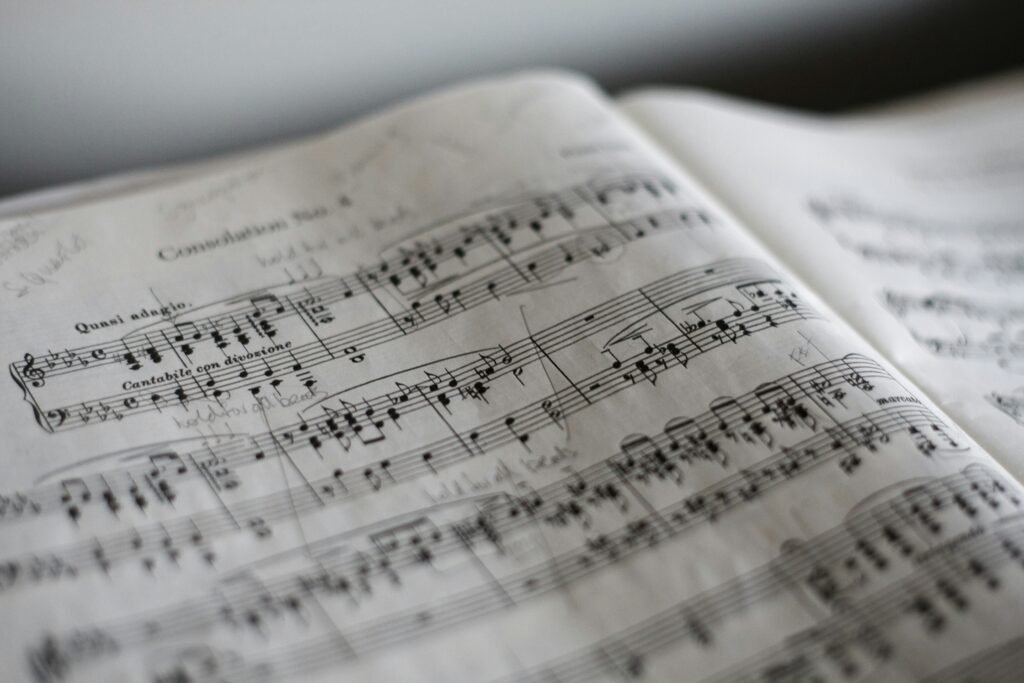Sure! Have you ever wondered how certain songs or pieces of music sound so pleasing to our ears? Harmony and chord progression play a crucial role in creating that magical and pleasing sound we all love. In simple terms, harmony refers to the combination of different musical notes played together simultaneously, creating a rich and full sound. On the other hand, chord progression is the sequence in which these harmonies change, giving the music a sense of movement and structure. Understanding the basics of harmony and chord progression is like unlocking the secret code to creating beautiful and captivating music. So, let’s dive into the world of music theory and discover the fascinating world of harmony and chord progression.

Understanding Harmony
What is harmony?
Harmony refers to the combination of different musical notes played simultaneously, creating a pleasing and coordinated sound. It is an essential aspect of music and is often described as the vertical aspect of music, contrasted with melody, which is the horizontal aspect. Harmony adds depth, richness, and emotion to a piece of music by creating a sense of unity and balance.
The role of harmony in music
Harmony plays a crucial role in music by providing a foundation for melodies and contributing to the overall structure and emotional impact of a composition. It helps to establish the mood and atmosphere of a piece, evoking different emotions such as joy, sadness, tension, or tranquility. Harmony also creates a sense of resolution and tension release, making the music satisfying to the ear.
The importance of harmony in composition
In composition, harmony is indispensable for creating a cohesive and coherent piece of music. It provides a framework for organizing the individual musical ideas and elements, allowing them to work together harmoniously. By understanding and utilizing harmony effectively, composers can create beautiful and impactful music that resonates with listeners.
Elements of Harmony
Consonance and dissonance
Consonance and dissonance are two fundamental concepts in harmony. Consonance refers to the pleasant, stable, and harmonious combination of musical tones, while dissonance refers to the less stable, tense, and unresolved combination of tones. The interplay between consonance and dissonance creates tension and release, adding variety and interest to a piece of music.
Melody and harmony
Melody and harmony are intertwined elements in music. Melody refers to a sequence of musical notes played consecutively, while harmony provides the accompanying chords and support to the melody. The harmony complements and enhances the melody, creating a harmonious blend of different voices and instruments.
Chords and chord progressions
Chords are the building blocks of harmony. A chord is a simultaneous combination of three or more notes played together. It consists of a root note, which gives the chord its name, and additional notes that create the desired quality and character. chord progressions refer to the sequence of chords used in a piece of music. They provide structure and movement, guiding the listener through different harmonies and creating a sense of progression and resolution.
What are Chords?
Definition of a chord
A chord is defined as a harmonic unit consisting of at least three different notes played simultaneously. The notes are typically spaced out in intervals of thirds and are built upon a specific root note, which establishes the chord’s name and tonal center. Chords can be played on various instruments, such as piano, guitar, or even sung by a choir.
Types of chords
There are various types of chords, each with its own characteristic sound and function. The most common types include major chords, minor chords, diminished chords, and augmented chords. Major chords have a bright and happy sound, while minor chords evoke a more sad or melancholic feeling. Diminished chords create tension and instability, while augmented chords add a sense of tension and excitement.
Building chords
Chords are typically constructed by stacking thirds on top of each other. This means that each note in the chord is separated by an interval of a third. The notes used to build a chord are selected from a scale or a specific key, resulting in different chord qualities and tensions. By understanding the relationships between the notes in a scale and the available chord options, composers can create harmonies that enhance their musical compositions.
Chord Progressions
What is a chord progression?
A chord progression is a series of chords played one after another. It forms the backbone of a song or composition, creating a sense of movement and development. Chord progressions can vary in length and complexity, ranging from simple two-chord progressions to more intricate sequences. They play a significant role in determining the overall mood, energy, and emotional impact of a piece of music.
Common chord progressions
There are countless chord progressions used in various genres of music. Some common ones include the I-IV-V progression, the I-V-VI-IV progression, and the I-VI-IV-V progression. The I-IV-V progression, also known as the “three-chord trick,” is often found in rock, blues, and pop music and provides a familiar and catchy sound. The I-V-VI-IV progression is frequently used in pop music, while the I-VI-IV-V progression can be found in many classic rock songs.
Using chord progressions in composition
Chord progressions serve as a foundation for composing melodies, harmonies, and even lyrics. They offer a framework to explore different musical ideas and structures, allowing composers to create unique and memorable compositions. By experimenting with different chord progressions, composers can manipulate the emotional impact of their music, crafting moments of tension and resolution to engage and captivate the listener.

Harmonic Function
Tonic
In harmony, the tonic is the central or home note of a key or scale. It provides a sense of stability and resolution, serving as a resting point for the listener’s ear. In a chord progression, the tonic chord (often denoted as the Roman numeral “I”) is the most frequently used and establishes the tonal center of a piece of music.
Dominant
The dominant chord (often denoted as the Roman numeral “V”) is the chord that creates tension and seeks resolution to the tonic. It has a strong and powerful sound and is commonly used to build anticipation before resolving back to the tonic chord. The dominant chord adds energy and drive to the music, creating a sense of forward motion.
Subdominant
The subdominant chord (often denoted as the Roman numeral “IV”) is the chord that provides a sense of contrast and preparation for the dominant. It is less tense than the dominant chord but still creates a feeling of movement away from the tonic. The subdominant chord is frequently used in chord progressions to build tension before resolving to the dominant and, eventually, the tonic.
Modulation
Modulation refers to a key change within a piece of music. It occurs when the tonal center shifts from one key or tonic to another. Modulation adds variety and contrast to a composition, keeping the listener engaged and interested. It is often used to create a sense of tension and release or to explore different emotional moods.
Cadences
Definition of cadence
A cadence is a musical event that signifies the end of a musical phrase, section, or piece. It provides closure and resolution to the listener, giving a sense of finality. Cadences act as punctuation marks in music, guiding the listener through the musical structure and creating a satisfying conclusion.
Types of cadences
There are several types of cadences, with each providing a different level of resolution and finality. The most common cadence types are the authentic cadence, plagal cadence, half cadence, and deceptive cadence. An authentic cadence consists of the dominant chord resolving to the tonic and is considered the strongest and most conclusive. A plagal cadence, often associated with a peaceful or spiritual feeling, involves the subdominant chord resolving to the tonic. A half cadence ends on the dominant chord, creating a sense of temporary pause or incompleteness. Finally, a deceptive cadence provides surprise by resolving to a chord other than the expected tonic.
The role of cadences in music
Cadences play a crucial role in guiding the listener’s expectations and providing a sense of structure and closure. They help to divide a piece of music into smaller sections, such as verses and choruses, and create a natural flow and rhythm. Cadences also add emotional impact by creating moments of tension and resolution, heightening the listener’s engagement and enhancing the overall musical experience.

Voice Leading
What is voice leading?
Voice leading is the art of moving individual musical voices or parts smoothly and melodically within a chord progression or composition. It involves carefully selecting and arranging the notes of each voice to create harmonic continuity and clarity. Voice leading ensures that each voice moves in a logical and pleasing manner, creating smooth transitions and avoiding dissonant clashes.
Principles of voice leading
There are several principles of voice leading that guide composers in creating harmonically cohesive music. One principle is maintaining independence and clarity between the different voices within a chord progression. Each voice should maintain its own melodic line while working harmoniously with the other voices. Another principle is avoiding parallel fifths or octaves, as these intervals can create a sense of instability and detract from the overall harmony. Composers also consider the individual melodic qualities of each voice to create interesting and engaging interactions between the voices.
Using voice leading to create smooth transitions
Voice leading is particularly important when transitioning from one chord to another. By carefully selecting which notes to move and how they transition, composers can create seamless and fluid progressions. Smooth voice leading helps to maintain a cohesive and unified sound throughout the composition, ensuring that the harmonic transitions are pleasing to the ear and enhancing the overall musical experience.
Harmonizing Melodies
Melody harmonization techniques
When harmonizing melodies, composers have various techniques to choose from. One common technique is using chords that contain the melody note as the highest note, creating a sense of unity between the melody and harmony. Composers can also harmonize the melody by adding supporting chords that complement the underlying harmonies. Another technique is adding countermelodies or harmonizing in multiple voices, enriching the musical texture and adding complexity to the harmonization.
Creating harmonies for different genres
Different musical genres often have their own conventions and expectations when it comes to harmonizing melodies. In classical music, harmonization tends to follow traditional Western classical harmony rules, emphasizing complex and sophisticated chord progressions. In jazz, harmonization often includes extended chords and alterations, allowing for more complex and colorful harmonies. In pop music, harmonization is often more straightforward and emphasizes catchy and simple chord progressions that support the melody.
Developing harmonies for specific effect
Harmonization can be used to evoke specific emotions or create desired effects in a composition. By carefully selecting chord qualities, inversions, and voicings, composers can enhance the emotional impact of the melody. Major chords can create a sense of brightness and happiness, while minor chords can evoke a more melancholic or mysterious feeling. Composers can experiment with different harmonization techniques to create the desired atmosphere and emotional response from the listener.
Harmonization in Popular Music
Harmonizing pop songs
Harmonizing pop songs often involves creating simple yet effective chord progressions that support the catchy melodies. In many cases, harmonization in pop music is achieved through a combination of basic triads and power chords. The focus is on creating a strong and memorable foundation for the melody while keeping the harmonies accessible and easy to follow for the listener.
Role of harmony in popular music production
Harmony plays a crucial role in popular music production. It helps to create the overall sound and atmosphere of a song, contributing to its genre and style. Harmonies provide a backdrop for the vocals and instrumental parts to shine, adding depth and complexity to the music. In popular music production, harmony is often crafted to create a balance between familiarity and innovation, ensuring that the music is both engaging and commercially appealing to a wide audience.
Harmonization techniques used in different genres
Different genres of popular music employ various harmonization techniques to achieve their distinct sounds. In rock music, harmonization often involves power chords, double stops, and layered guitar parts to create a thick and heavy sound. In funk and R&B, harmonization focuses on creating tight and precise vocal harmonies and chord progressions that support the rhythmic and groovy nature of the music. In electronic music, harmonization can involve the use of synthesizers and programming to create intricate and modern chord progressions.
Analysis of Famous Progressions
Studying popular chord progressions
Analyzing famous chord progressions can provide valuable insights into how harmony is used in different musical contexts. By studying the chord choices, melodies, and overall structure of well-known songs, composers can learn from the techniques and approaches used by successful musicians. This analysis helps develop a deeper understanding of the intricacies of harmony and how it can be leveraged to create compelling compositions.
Analyzing harmonic choices in famous songs
The harmonic choices made in famous songs greatly contribute to their success and impact. By examining the chord progressions, key changes, and use of harmony within these songs, composers can gain inspiration and insights for their own compositions. Analyzing the harmonic choices in famous songs allows composers to understand how different chords and chord progressions can elicit specific emotions and enhance the overall musical experience.
Applying the knowledge to your own compositions
The knowledge gained from analyzing famous progressions can be applied to one’s own compositions to create unique and captivating music. By understanding the role and function of harmonies in different genres and musical contexts, composers can make informed decisions about chord progressions, voice leading, and harmonic choices that best serve their musical ideas. Applying this knowledge enables composers to craft harmonically rich and engaging compositions that resonate with their intended audience.
In conclusion, understanding harmony and chord progression is essential for any musician or composer. Harmony adds depth, emotion, and structure to music, while chord progressions create movement, tension, and resolution. By exploring the elements of harmony, chords, and cadences, composers can craft harmonically cohesive and emotionally impactful compositions. Voice leading techniques and harmonizing melodies further enhance the musical experience, while the analysis of famous progressions provides inspiration and guidance. Ultimately, harmony is a fundamental aspect of music that enriches both the listener and the composer, making the musical journey a truly harmonious and fulfilling experience.

Jonse Becker, a seasoned guitarist and music aficionado, founded his blog to share his passion for all things guitar. With over 20 years of experience, Jonse expertly navigates the realms of vintage acoustics and modern electrics, offering readers a rich blend of technical knowledge, history, and industry trends.

